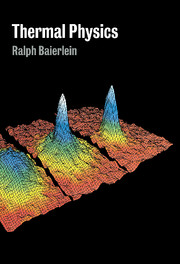Book contents
- Frontmatter
- Contents
- Preface
- 1 Background
- 2 The Second Law of Thermodynamics
- 3 Entropy and Efficiency
- 4 Entropy in Quantum Theory
- 5 The Canonical Probability Distribution
- 6 Photons and Phonons
- 7 The Chemical Potential
- 8 The Quantum Ideal Gas
- 9 Fermions and Bosons at Low Temperature
- 10 The Free Energies
- 11 Chemical Equilibrium
- 12 Phase Equilibrium
- 13 The Classical Limit
- 14 Approaching Zero
- 15 Transport Processes
- 16 Critical Phenomena
- Epilogue
- Appendix A Physical and Mathematical Data
- Appendix B Examples of Estimating Occupation Numbers
- Appendix C The Framework of Probability Theory
- Appendix D Qualitative Perspectives on the van der Waals Equation
- Index
8 - The Quantum Ideal Gas
Published online by Cambridge University Press: 05 June 2012
- Frontmatter
- Contents
- Preface
- 1 Background
- 2 The Second Law of Thermodynamics
- 3 Entropy and Efficiency
- 4 Entropy in Quantum Theory
- 5 The Canonical Probability Distribution
- 6 Photons and Phonons
- 7 The Chemical Potential
- 8 The Quantum Ideal Gas
- 9 Fermions and Bosons at Low Temperature
- 10 The Free Energies
- 11 Chemical Equilibrium
- 12 Phase Equilibrium
- 13 The Classical Limit
- 14 Approaching Zero
- 15 Transport Processes
- 16 Critical Phenomena
- Epilogue
- Appendix A Physical and Mathematical Data
- Appendix B Examples of Estimating Occupation Numbers
- Appendix C The Framework of Probability Theory
- Appendix D Qualitative Perspectives on the van der Waals Equation
- Index
Summary
By now, the classical ideal gas should be a familiar system. We can turn to the full quantum theory of an ideal gas. The applications are numerous, and some will be examined in chapter 9. The present chapter develops an effective technique for working with a quantum ideal gas.
Coping with many particles all at once
Every macroscopic system consists of a great many individual particles. Coping with all of them simultaneously, even if only statistically, can be a daunting task. A flow chart will help us to see some of our accomplishments and to see what steps lie ahead. Figure 8.1 displays such a chart on the supposition that the system consists of one species of particle only, for example, N electrons or N helium atoms (of a specific isotope).
If the forces between the particles must be included, then the analysis is difficult. Moreover, there is no general algorithm for proceeding, not even by computer. To be sure, the canonical probability distribution usually is applicable and provides estimates in principle, but the actual evaluation of the partition function, say, defies a direct approach. We have, however, successfully dealt with one such difficult situation. The Debye model for a solid incorporates the inter-particle forces, for example, those between adjacent copper atoms in a crystal. The forces ensure that the motions of adjacent atoms are correlated, and the correlation leads to sound waves, the theoretical basis of the Debye model.
- Type
- Chapter
- Information
- Thermal Physics , pp. 166 - 181Publisher: Cambridge University PressPrint publication year: 1999

